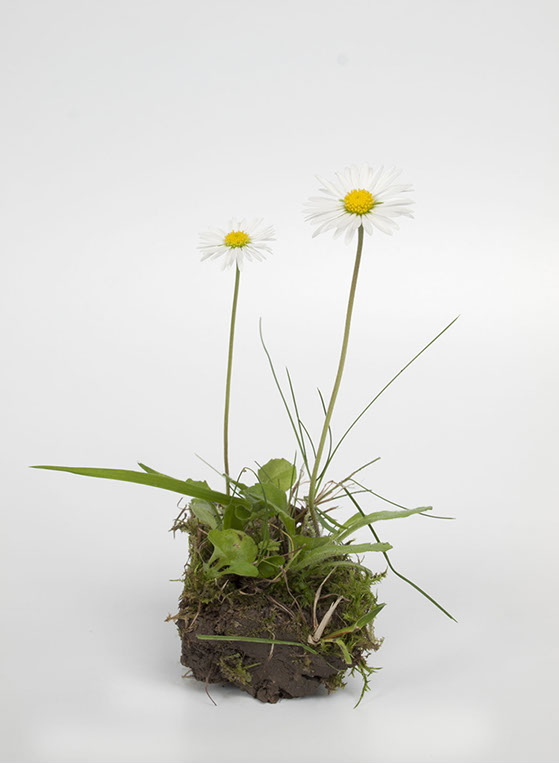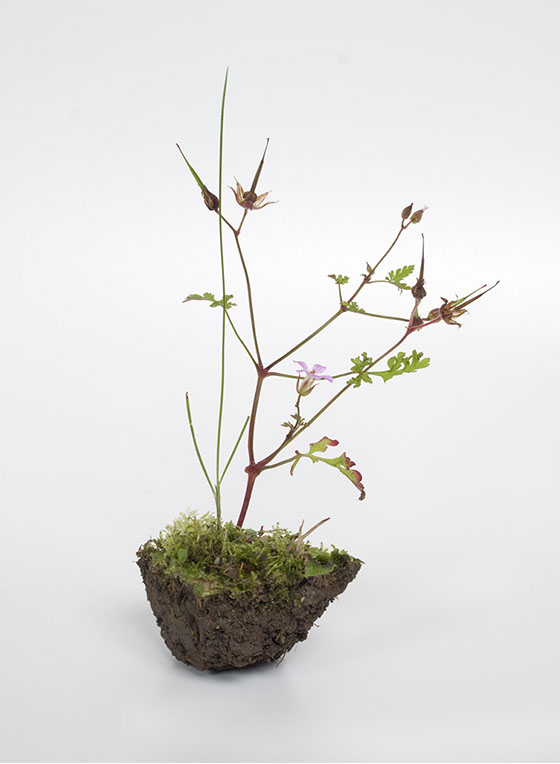Wildnis
Viele Arbeiten Robert Zahornickys zeigen keine “Wirklichkeiten” (im Sinne herkömmlicher fotografischer Abbildungstreue), sondern vielmehr Simulationen von Wirklichkeit. - So weckt die Fotoserie “Horizonte” (1996) Assoziationen mit realen Landschaftsphänomenen, obwohl es sich in Wirklichkeit um Abbildungen des reinen Sonnenlichts, d.h. um manipulierte Direktbelichtung des Films in der Kamera handelt. Oder aber er lässt wie in “terraforming” (1994) Nahaufnahmen von Algenformationen mittels hochauflösendem Film und Laserprint-Technik wie Satellitenbilder der Erdoberfläche aussehen.
Zahornickys neueste Fotoserie “Wildnis” handelt von verschiedenen Realitätsebenen: Angeregt von Albrecht Dürers Aquarell “Das große Rasenstück” gibt es auf der ersten Realitätsstufe zunächst “wirklichkeitstreue” Abbildungen von wild wachsenden Pflanzen samt Erde und Wurzeln, eigenhändig ausgegraben und im Atelier vor strahlend weißem Hintergrund fotografiert.
Im nächsten Arbeitsschritt wurden Rasenstücke aus einem und Pflanzen aus einem anderen Gebiet entnommen und miteinander kombiniert, was einem botanisch unbedarften Betrachter auf den ersten Blick nicht unbedingt auffällt. Die dritte Generation der “Wildnisse” schließlich repräsentiert den Typus des “klassischen” Blumenstillebens - nur dass anstelle des üblichen Schnittblumen-Arrangements Imitationen aus Plastik, Holz oder Häkelgarn getreten sind.
Kunsthistorisch betrachtet, weisen Zahornickys “Wildnisse” tatsächlich die Merkmale gemalter Blumenstilleben auf: den für dieses Genre charakteristischen neutralen, die Raumsituation verunklärenden Hintergrund und die imaginäre Zusammenstellung von Pflanzen. - Vor allem im 17. Jahrhundert pflegten Künstler, Blumen, die eigentlich zu verschiedenen Jahreszeiten blühen, zu einem Strauß arrangiert darzustellen oder sie kombinierten heimische, in der Natur beobachtete Pflanzenarten mit exotischen, die sie den Illustrationen in Florilegien nachempfanden. Selbst “Stilleben im Freien”, also Wald- und Wiesenstücke, waren - trotz hyperrealistischer Wirkung der naturgetreu wiedergegebenen Arten - keine Abbilder natürlicher Lebensgemeinschaften, sondern komponierte Phantasien.
Trotzdem die “Wildnisse” ursprünglich von Dürers “Rasenstück” inspiriert waren, geht es Zahornicky dabei weder um vordergründige fotokünstlerische Reprisen kunsthistorischer Vorbilder noch um Kontemplation des Naturschönen als vielmehr um die Schaffung einer neuen Wirklichkeit. Seit den 70er Jahren entwickelte die Fotografie zunehmend Unbehagen gegenüber authentischen Bildern. Es kündigte sich ein Wechsel an, der dann vollends in den 80er Jahren zur Wirkung kam. Nicht mehr die Interpretation, sondern die Konstruktion neuer, unbekannter Bildwelten rückte in den Mittelpunkt fotografischer Aktivitäten. - “Es wurden Welten inszeniert, nur um sie zu fotografieren.” Für Robert Zahornicky steht dabei das Konzept im Vordergrund, nicht der unmittelbare Augenschein, sondern die Denkarbeit, die nötig ist, um das Konzept zu rekonstruieren. Dieses Konzept gründet sich auf Reflexionen über das Medium Fotografie und ihre Fähigkeit bzw. Unfähigkeit, Wirklichkeit abzubilden.
In diesem Zusammenhang sei auf Magrittes berühmtes Bild “Ceci n‘est pas une pipe” verwiesen, was als Malereireflexion, unter dem Blickpunkt Wirklichkeit gelesen, heißt: Das ist keine reale Pfeife, das ist eine gemalte Pfeife, ein zweidimensionales Bild von einer Pfeife. Somit ist auch eine fotografierte Pfeife keine wirkliche Pfeife, sondern als zweidimensionale Fläche ein Bild von einer Pfeife. Diese Schlussfolgerung ist insofern interessant, als viele zeitgenössische Fotokünstler bestrebt sind, die Charakteristika der Malerei auf die Fotografie zu übertragen. Nämlich sowohl hinsichtlich der Ästhetik als auch der erfundenen Wirklichkeit. Cindy Sherman beispielsweise war eine der ersten, die diese Strategie erfolgreich angewendet hat: “Der fiktive Inhalt ihrer Werke, die großen Formate, die Intensität der Farben, die Komposition im Sinne der klassischen Malerei und die Behandlung des Raumes lassen den Eindruck entstehen, dass es sich eher um Gemälde als um Fotografien handelt.” (Joshua P. Smith) Das trifft - im Fall der “Wildnisse” - auch auf Robert Zahornicky zu. Und wie bei Sherman handelt es sich um Täuschungen bzw. um Simulationen im Sinne Jean Baudrillards. - Das oft zitierte Schlagwort vom Verschwinden der Realität ist eine der grundlegenden Annahmen in Baudrillards Theorie der Simulation. Wobei nicht eigentlich die Realität verschwindet, sondern eher die Formen bekannter und vertrauter Realität, da es in der medienbeherrschten Gegenwart nicht mehr möglich ist, das Reale vom Imaginären zu unterscheiden, weil die Simulation das Wahrheitsprinzip beseitigt.
Früher, so Baudrillard, gab es eine besondere Klasse von allegorischen und ein wenig diabolischen Gegenständen: Spiegel, Bilder, Kunstwerke - Simulakren, die jedoch als solche manifest und durchschaubar waren (man verwechselte die Vorlage nicht mit der Imitation). Das Vergnügen bestand vor allem darin, etwas “Natürliches” in dem zu entdecken, was künstlich und imitiert war. Heute, wo das Reale und das Imaginäre zu einer gemeinsamen operationalen Totalität verschmolzen sind, herrscht die ästhetische Faszination überall: es ist die unterschwellige Wahrnehmung (eine Art sechster Sinn) des Tricks, der Montage, des Szenarios, von der Überbelichtung der Realität bis zum Ausleuchten der Modelle. Eine Art unfreiwilliger Immanenz überlagert alles, eine taktische Simulation, ein unentwirrbares Spiel, mit dem sich ein ästhetischer Genuss verbindet, der Genuss an der Lektüre und den Spielregeln.
Einem Verwirrspiel unterliegt letztlich auch der Betrachter der “Wildnisse”: Sind die Fotografien der ersten, “unmanipulierten” Stufe tatsächlich genaue Abbilder eines Rasenstückes, wenn sie zugleich das Darunter und das Darüber sichtbar machen und dieser Naturausschnitt noch dazu im Studio aufgenommen wurde? Wie lassen sich davon die “Fakes” unterscheiden, die manchmal so gut getarnt sind, dass es gar nicht auffällt, dass etwas von hierhin nach dahin verpflanzt wurde? Und sehen gehäkelte Nelken von der Ferne nicht ganz “natürlich” aus, während sie sich bei näherer Betrachtung in Pixel auflösen wie ein digitales Bild?
Alexandra Schantl
Wilderness
Many of Robert Zahornicky’s works do not show reality (in the accepted sense of the term as a traditional photographically true depiction of things); they are more simulations of reality. In his series of photos entitled ‘Horizonte’ [Horizons] (1996), associations with real pastoral phenomena are evoked, despite their actually being representations of pure sunlight – direct exposures onto film manipulated in the camera. Or as in his work ‘terraförmig’ where by means of high-resolution film and laser technology, close-ups of algae in various forms are made to look like satellite pictures of the earth’s surface.
In his latest series of photos, ‘Wildnis’ [Wilderness], Zahornicky touches on different levels of reality. At the first level of reality and drawing inspiration from Albrecht Dürer’s ‘Das große Rasenstück’ [The large patch of grass] wild flowers with their roots and soil are depicted. The artist dug them up himself and the photographs were shot in his studio against a gleaming white backdrop.
At the next level, patches of grass were taken from one region and plants from another and subsequently mixed together. At first sight for a person not versed in botany, the combination is not apparent. Ultimately the third generation of ‘wildernesses’ is typical of the ‘classical’ still life: a depiction of a static arrangement of flowers – the only difference being that instead of the customary cut flowers, the arrangements are made up of plastic, wood and crocheted imitations.
From the standpoint of an art historian, Zahornicky’s ‘wildernesses’ display all the traits of a still life painting of a flower arrangement: a neutral and slightly obfuscated background and an imaginary arrangement of greenery typical of the genre. In the 17th century in particular, artists used to depict in one and the same bouquet flowers that blossomed at different times of the year or they were wont to mingle plants they had observed in nature with exotic blooms reminiscent of the illustrations in florilegia. For all the hyperrealistic reality of their true-to-life representation of the species, still lifes sur l’herbe depicting woods and meadows do not portray natural living communities; they are fantasies composed.
Despite his ‘wildernesses’ being inspired by Dürer’s Rasenstück, Zahornicky is not so much concerned with overtly repeating what has gone before in the history of art. Nor is he bent upon contemplating the beauty of nature. He is much more concerned with the creation of a new reality. From as far back as the seventies, the world of photography has been increasingly at odds with authentic pictures. A change was in the offing which then came into full effect in the eighties. No longer the interpretation, but the construction of a new unknown world of images became the focus of photographic activity. “Worlds were created merely for photography’s sake”. For Robert Zahornicky the concept comes to the fore - not the immediate appearance, but the intellectual activity that is needed to reconstruct the concept. The concept is based on reflections about photography as a medium and its ability and/or inability to represent reality.
In this context, attention is drawn to Magritte’s renowned picture ‘Ceci n’est pas une pipe’. Viewed from the standpoint of reality, it is a painter’s reflection and points to its not being a real pipe; it is a painting of a pipe, a two-dimensional picture of a pipe. In the same vein, a photograph of a pipe does not show a real pipe; it is but a picture of a pipe on a two-dimensional surface. The logical conclusion is interesting insofar as many contemporary art photographers are endeavouring to transport the characteristics of painting to the realm of photography. In terms of both aesthetics and reality invented. For example, Cindy Sherman was one of the first to apply this strategy with any measure of success. “The fictional content of her work, the large formats, the intensity of her colours, the composition in the sense of classical painting and her treatment of space create the impression that it is more a question of painting than photography”. (Joshua P. Smith) As far as his wildernesses are concerned, the same could be said of Robert Zahornicky. As with Sherman it is a question of deception and/or simulations as defined by Jean Baudrillard. The oft repeated slogan, the disappearance of reality, is one of the basic assumptions in Baudrillard’s simulation theory. Whereby it is not so much a matter of reality itself disappearing, but rather the forms of reality which we know and have grown accustomed to. In our day and age and with the dominance of the media it is no longer possible to distinguish between the real and the imaginary, because simulation has done away with the principle of truth.
In earlier times, according to Baudrillard, there was a special category of allegorical, less diabolical objects: mirrors, pictures, works of art – simulacra which were clearly manifest and transparent (the original could not be mistaken for an imitation). The primary enjoyment lay in discovering something natural in something that was artificial and imitative. Today, with the real and the imaginary having merged into a common operational totality, aesthetic fascination is predominant: subliminal perception ( a kind of sixth sense) of the trick, the montage, the scenario and the overexposure of reality until the subjects fade away. A kind of involuntary immanence pervades everything, a tactical simulation, an indecipherable game linked to aesthetic enjoyment: the joy of reading and determining the rules of the game.
In the ultimate analysis, anybody looking at Zahornicky’s wildernesses falls prey to the same game of deception. Are the photographs of the first unmanipulated stage really exact depictions of a patch of grass, given that they also show what was above and below and the photographs were taken in a studio? How can they be distinguished from those fakes which are so well disguised that their having been transplanted from one place to another is not apparent? And don’t crocheted carnations look just as ‘natural’ from a distance, despite their dissolving upon closer examination into pixels like any other digitised image?
Alexandra Schantl / Translated by Peter Lillie
-crop-u23112.jpg?crc=139006168)
-crop-u23149.jpg?crc=133587971)
Wildnis #269, C-Print auf Alu, 80 x 60 cm · 2005
Wildnis #90, C-Print auf Alu, 80 x 60 cm · 1997
-crop-u23132.jpg?crc=371138903)
-crop-u23151.jpg?crc=388772776)
Wildnis #243, C-Print auf Alu, 80 x 60 cm · 2001
Wildnis #249, C-Print auf Alu, 80 x 60 cm · 2002


Bonsai 002, C-Print auf Alu, 80 x 60 cm · 2013
Bonsai 003, C-Print auf Alu, 80 x 60 cm · 2013